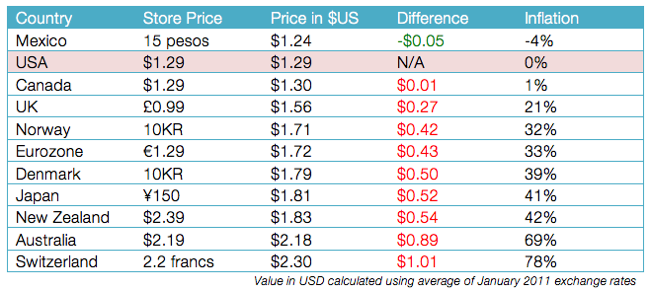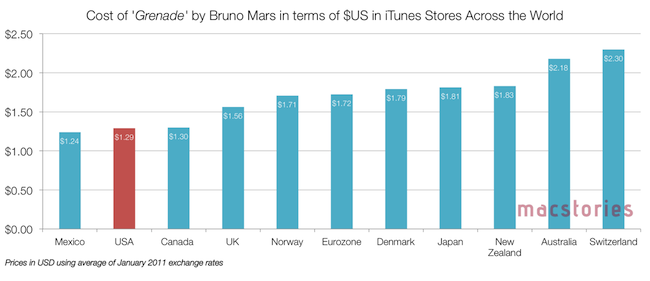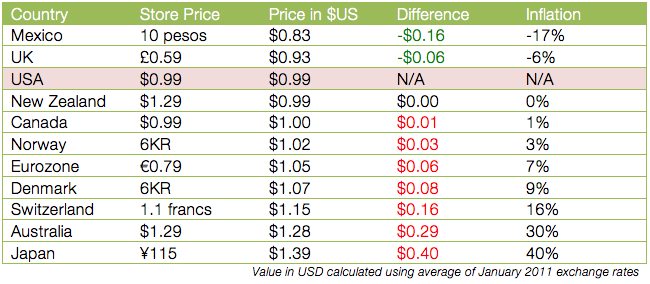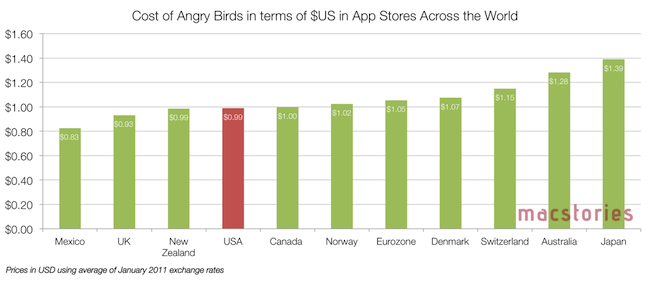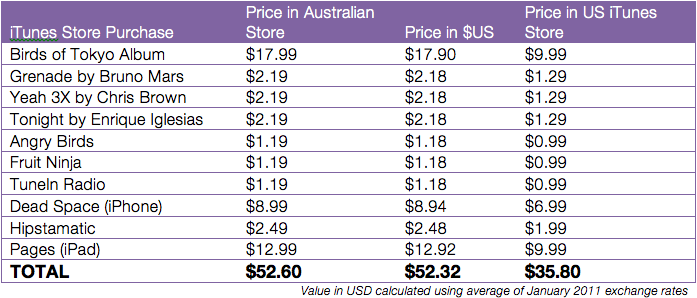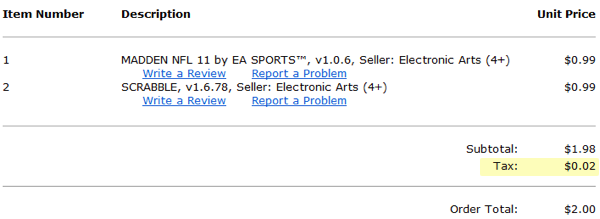Over the weekend I curiously started investigating whether Australians had been getting a progressively worse deal for their iTunes purchases as the Australian dollar rose from USD$0.60 to parity whilst iTunes prices stayed constant. The answer is most definitely a yes but it doesn’t just apply to Australians, and the extent of the price disparity is larger than I had thought.
Whilst Apple is entitled to have different prices for different regions, it doesn’t really need to. Furthermore the extent to which there is price disparity is very extensive for the music section of the store and this article aims to bring the inequity to light. Apple has previously been under similar pressure but the exchange rates reverted back, I would hope Apple again reconsiders their iTunes pricing system now when exchange rates have pushed the disparity to a very high level.
This turned into a bigger article than I had expected so here are the key things I cover and keep reading after the break for a full run down with tables, graphs and more.
- iTunes uses fixed prices (i.e. $0.99, $1.29 etc.) and for stores outside the US these price levels were converted using a very conservative prediction of the future value of a particular currency
- The price levels in non-US stores seem not to have been updated in a long time, yet the value of the non-US currencies have mostly appreciated since then. As a result people purchasing from most of the non-US iTunes Stores are now paying more than US customers and Apple is earning more from those customers
- The conversion rate is different for the App Store and Music store (and likely the other stores too), the App store conversion rates are much more appropriate and the price disparity is less extreme.
Updated on April 27 2011 - see end of article for revised figures and comment.
How I have I gained my results?
I went to each iTunes store that had a music and app store section (those with only app Stores are treated differently) and looked up a common song (Grenade by Bruno Mars) and a common app (Angry Birds) and recorded what each country’s iTunes Store sold it for in their currency. I then converted those figures to the US currency using the average January 2011 exchange rate for the respective currencies.
The Results
So first the Music section of the iTunes store, the below graph and table details everything pretty well and are ordered from the cheapest to most expensive.
Note that I have used the term ‘Eurozone’ in referring to the group of iTunes stores in Europe that use the Euro and have the same prices including; Austria, Belgium, Finland, France, Germany, Greece, Ireland, Italy, Luxembourg, Netherlands, Portugal, Spain.
What is revealed is that Apple has a store that has some significant disparity in its pricing system when compared globally, except for Mexicans (who actually have greater purchasing power than they should with their weakened currency) and Canadians (whose dollar and iTunes prices were pretty much at parity).
British users are then the next least impacted by the price disparity, yet still having to pay one fifth more than US users for the same song. Things get progressively worse for those in the Eurozone with a 33% inflated figure and then Australia at a 69% higher price and finally there is Switzerland with 78% inflated figure. The disparity is so bad for the Swiss that they pay US$2.34 for a single song; US users could buy that same song and a 99c iPhone app like Angry Birds for that same cost and still have 2 cents spare!
What Apple seems to have done is just create a fixed currency exchange ratio when it opened the iTunes Stores outside the US. This was undoubtedly their simplest option when considering how to deal with currencies. It was set and forget. But they were much too conservative and should have regularly updated the prices in the non-US stores based on up-to-date exchange rate trends.
The App Store and a Different Conversion Rate?
Apple complicated things with the launch of the App Store that uses a different conversion rate! The below table and graph demonstrates the cost of Angry Birds on the various App Stores across the globe.
By looking at the inflation figures of the two tables, Apple clearly improved the equality of purchasing across the various app Stores. The highest inflation figure is now for Japan’s App Store and is at a much more moderate (but still excessive) 40%. This conversion rate still isn’t perfect but it is a big improvement for every country and even gives Brit’s greater purchasing power than their US friends. But for other countries like Australia, Switzerland and Japan there is still significant price disparity. To me it makes no sense for a digital good like Angry Birds that once created can be distributed across the world for virtually the same extremely minimal cost to have such a variety of prices when the developer has set it at the lowest price bracket of 99c.
(To be clear this article is not about complaining about developers who purposely set different prices for different regions, this is about Apple selling the same App at different prices despite the developer setting a global price of US$0.99.)
So seeing as I’m an Aussie and Australia is one of the most affected by this price disparity in iTunes, lets have a look at someone’s purchases they might make on the iTunes Store in Australia. The below graphic shows what this person purchased, a new release album, three current top hit singles, four iPhone apps and Pages for the iPad. It would cost the person AUD$52.60 or at January’s average exchange rate, USD$52.26. What would the exact same items cost on the US iTunes store? Why only $35.80.
That means the Australian customer paid an extra USD$16.46 which could have been used to purchase numerous other singles or apps (for example 16 more copies of Angry Birds could have been purchased).
Could it be the Tax?
Short answer is no, as far as I can tell Apple does not include the tax value in the price shown in the iTunes store (which is where I am getting the prices from) but rather adds the value of tax and adds it onto the emailed receipt you get after purchases. Even if I am wrong about that (pretty certain I’m not) most states/countries have sales taxes below 10% and would still fail to explain a large portion of price disparity in the music section of the iTunes Store.
The Solution Apple Already Implemented
So clearly for consumers in countries in which there are inflated prices for music and app purchases there is a problem that Apple should try and alleviate. One solution is selling and displaying everything in US dollars in the App Store. In fact Apple does this, except it is limited to the Stores operating in countries with only App Stores (some examples include China, Brazil and Indonesia). Apple could then go a step further and display the price in the users own currency, converting the US dollars on the fly with the up-to-date conversion rates.
I suspect the reason they haven’t already done this for every country is because currencies change frequently and can do so at a rapid pace and such changes in prices would probably confuse customers, and I’d tend to agree. So instead how about they re-adjust their conversion rates in a more frequent but not at a minute-by-minute rate? Once a month or even every quarter would do wonders for app and music price equality across the globe and it wouldn’t be too confusing either.
I’m seriously OK with paying a little more than my US brethren but that inflated price level should be no more than 10% at an absolute maximum. Because seriously, especially on the music front the conversion rate Apple currently uses is ridiculously out of date with the current state of currencies.
Apple’s Comment?
They never responded to any of my queries, but in an article The Sydney Morning Herald said;
Apple Australia said in response that content was not delivered on a global agreement, so converting from US to Australian dollars “is not relevant”.
April 27 Update - Still No Change From Apple and the Disparity is Getting Worse
Well three months later there has been no change in Apple’s iTunes price conversion and what’s worse is the USD has further depreciated against many of the other currencies used in various iTunes Stores. As a result the iTunes price disparity has worsened for every country, except for Japan, which has seen a very minor improvement. Looking at Australia alone, the price of the basket of goods has increased to what is now only a few cents short of a $20 surcharge on the price an American would pay in the US iTunes Store for the same digital goods.
Sure, only a few cents have been added onto the disparity that was there in January but the bigger issue is that this problem of price disparity in the iTunes Store is only getting worse. Apple should take more regular steps in adjusting for exchange rate volatility or ditch the exchange rate conversion all together and sell it all in US dollars – both of which I have detailed in the above section titled “The Solution Apple Already Implemented”.
I have updated the tables and graphs which you can open:
Angry Birds ($0.99) Price Across the World on iTunes [Graph] [Table]
$1.29 Song Price Across the World on iTunes [Graph] [Table]
Basket of Goods in Australia and US iTunes Store [Table]



